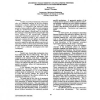Free Online Productivity Tools
i2Speak
i2Symbol
i2OCR
iTex2Img
iWeb2Print
iWeb2Shot
i2Type
iPdf2Split
iPdf2Merge
i2Bopomofo
i2Arabic
i2Style
i2Image
i2PDF
iLatex2Rtf
Sci2ools
ICRA
1993
IEEE
1993
IEEE
Geometric Characteristics of Antagonistic Stiffness in Redundantly Actuated Mechanisms
Parallel closed-chainmechanical architectures allow for redundant actuation in the force domain. Antagonistic actuation, afforded by this input force redundancy, in conjunction with nonlinear linkage geometry createsan effective stiffnessdirectlyanalogous to that of a wound metal spring. A general stiffness modelfor such systems is derived and it is shown that the constitutive relationshipbetweenactuationeffortand active stiffness is the second-order kinematic constraint(s) relating the actuation sites. The extent of stiffness modulation possible is then evaluated and necessaly conditions for fill stiffness modulation are obtained. Configuration dependent, second-order, geometricsingularitiesaffectingstiffnessgeneration are illustrated in termsof a three degree-of-freedomparallel spherical mechanismexample,and discussedin relalion to their more commonly investigated first-order counterparts.
ICRA 1993 | Relationshipbetweenactuationeffortand Active Stiffness | Robotics | Stiffness | Stiffness Modulation |
| Added | 08 Aug 2010 |
| Updated | 08 Aug 2010 |
| Type | Conference |
| Year | 1993 |
| Where | ICRA |
| Authors | Byung-Ju Yi, Robert A. Freeman |
Comments (0)

